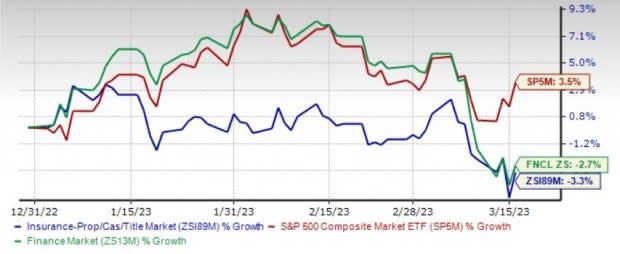CINF or CNA: Which P&C Insurance Stock Should You Buy Now?
Better pricing, an improving rate environment, exposure growth, prudent underwriting and solid capital position poise property and casualty insurers well amid a volatile market. However, an active catastrophe environment could weigh on the upside.
Global commercial insurance prices rose for 21 straight quarters though the magnitude has slowed down over the last eight quarters, per Marsh Global Insurance Market Index.
Better pricing ensures improved premiums and prudent claims payment. Per Deloitte Insights, gross premiums are estimated to increase about sixfold to $722 billion by 2030. China and North America should account for more than two-thirds of the global market, per the report. Per Deloitte Insights, trends like commercial lines witnessing growth at a faster pace than personal lines and homeowners’ premiums improving better than personal auto are likely to continue in 2023
The insurance industry is rate sensitive. The Fed has already made seven hikes in 2022 and one this year. An improving rate environment is a boon for insurers, especially long-tail insurers. The Fed has announced taking the interest rate to 5.1% in 2023. The current federal interest rate currently stands at 4.75%. Thus, there is more room for rate hikes in 2023.
Catastrophic events weigh on the underwriting profitability of insurers. Aon estimated global economic loss of $313 billion in 2022 from natural disasters while insured losses were over $130 billion.
Nonetheless, the insurance industry continues to witness accelerated digitalization. Players are investing heavily in technology to improve scale and efficiencies.
While a solid policyholders’ surplus will help the industry absorb losses, a sturdy capital level continues to aid insurers in pursuing strategic mergers and acquisitions, investing in growth initiatives, engaging in share buybacks, increasing dividends or paying out special dividends.
The industry has declined 3.3% year to date versus the Finance sector’s decrease of 2.7% and the Zacks S&P 500 composite’s rise of 3.5%.

Image Source: Zacks Investment Research
Here we focus on two property and casualty insurers, namely Cincinnati Financial Corporation CINF and CNA Financial Corporation CNA. Cincinnati Financial, with a market capitalization of $17.4 billion, markets property and casualty insurance. CNA Financial, with a market capitalization of $10.5 billion, offers commercial P&C insurance products, mainly across the United States. Both companies carry a Zacks Rank #2 (Buy). You can see the complete list of today’s Zacks #1 Rank (Strong Buy) stocks here.
Let’s now see how these P&C insurers have fared in terms of some of the key metrics.
Price Performance
Cincinnati Financial has gained 8.2% year to date against CNA Financial’s decline of 8.7% and the industry’s decrease of 3.3%.
Return on Equity (ROE)
CNA Financial has a return on equity of 11.3%, which exceeds Cincinnati Financial’s ROE of 6.3% and the industry average of 6.7%.
Dividend Yield
CNA Financial’s dividend yield of 4.5% tops Cincinnati Financial’s dividend yield of 2.5% and the industry average of 0.4%.
Debt-to-Equity
CNA Financial’s debt-to-equity ratio of 31.5 is higher than the industry average of 26 as well as Cincinnati Financial’s reading of 8.6.
Growth Projection
The Zacks Consensus Estimate for 2023 earnings indicates a 21.2% increase from the year-ago reported figure for CINF and 10.4% for CNA.
The consensus estimate for 2024 earnings indicates a 14.8% increase from the year-ago reported figure for CINF and 3.5% for CNA.
The expected long-term earnings growth rate is pegged at 17.7% for CINF, outperforming the industry average of 14.6% and CNA’s 5% earnings growth rate.
Combined Ratio
The combined ratio represents underwriting profitability of an insurer. CNA’s combined ratio was 93 in 2022, improving 300 basis points (bps) from 2021 while the same for CINF was 98.1, deteriorating 980 bps year over year.
Valuation
CNA Financial’s price-to-book of 1.19 is cheaper than the industry average of 1.37 and Cincinnati Financial’s valuation multiple of 1.66.
Moreover, CNA Financial has a Value Score of A. Back-tested results have shown that stocks with a Style Score of A or B combined with a Zacks Rank #1 or #2 offer better returns.
To Conclude
Our comparative analysis shows that CNA Financial has the edge over Cincinnati Financial with respect to return on equity, dividend yield, combined ratio and valuation. CINF outpaces CNA on price performance, growth projection and leverage.
Want the latest recommendations from Zacks Investment Research? Today, you can download 7 Best Stocks for the Next 30 Days. Click to get this free report
Cincinnati Financial Corporation (CINF) : Free Stock Analysis Report
CNA Financial Corporation (CNA) : Free Stock Analysis Report

 Yahoo Finance
Yahoo Finance 